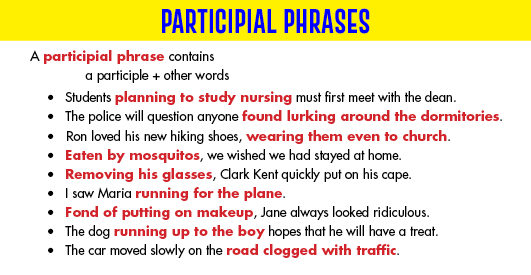When should I use a participial phrase?

What is a participial phrase? A participial phrase is a group of words consisting of a participle and the modifier and/or nouns, pronouns or noun phrases that function as the direct objects, indirect objects, or complements of the action or state expressed in the participle. Guide to Grammar and Style For example:
- Removing his pants, Ron jumped into the water to save the child.
- Theresa observed her father jogging along the path.
- Tots interested in music early develop powerful intellectual skills.
- Having been a pole vaulter, Gale knew the importance of exercise.
Have you tried the FREE PaperRater automated proofreader yet? What are you waiting for?

Placement of a participial phrase
To prevent confusion, a participial phrase should always be placed as close to the noun it modifies as possible. In addition, the noun must be clearly stated.- A Carrying a heavy pile of books, his foot caught on a step.
- B Carrying a heavy pile of books, he caught his foot on a step.
Punctuation of a participial phrase
When a participial phrase begins a sentence, a comma should be placed after the phrase.- Lifting weights for two hours, Ron developed sore muscles.
- Arriving at the accident, Ben discovered that it was too late.
- The art museum, destroyed by a hurricane, was never rebuilt.
- Mr. Roberts, watching his grandchildren play, drifted in and out of sleep.
- The guy wearing the orange tuxedo is my cousin.
- The student scoring the highest grade on the English exam will receive a large cash award.
- The local residents often saw Bob wandering through the streets.
- Kenneth nervously watched the woman, alarmed by her large gun.
